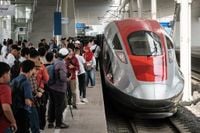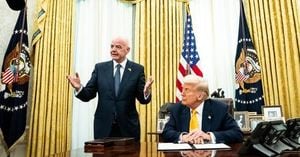On October 30, 2025, the world’s attention turned to South Korea, where two of the globe’s most influential leaders—Donald Trump and Xi Jinping—sat down for a summit that many hoped would mark a turning point in U.S.-China relations. Yet, as the dust settled, the outcome felt more like a stalemate than a breakthrough, with both leaders making concessions under the shadow of mounting domestic economic pressures, according to Nikkei.
What drove Trump and Xi to the negotiating table with such urgency? The answer, it seems, lies not just in geopolitics but in the troubled economic landscapes each faces at home. For China, the stakes are particularly high. Xi Jinping, once known for his assertive “wolf warrior” diplomacy, has recently taken a more measured approach—a shift that many observers attribute to China’s underperforming domestic economy. As Nikkei notes, the Chinese leader’s decision to avoid aggressive rhetoric during the summit was no accident; it was a calculated move born of necessity.
“The pressure of their underperforming domestic economies pushed Donald Trump and Xi Jinping to make concessions during their summit in South Korea on Oct. 30,” reported Nikkei. This mutual vulnerability set the tone for a meeting that, while cordial, produced no clear victor. Instead, both leaders left the table with the sense that compromise was not only inevitable but essential.
Meanwhile, China’s ambitions on the international stage are facing new headwinds. Nowhere is this more evident than in Beijing’s much-publicized high-speed rail projects across Asia. Once heralded as proof of China’s state-led modernization model, these sprawling infrastructure ventures are now struggling under the weight of delays, disappointing passenger numbers, and ballooning debts. According to Bloomberg, the flagship bullet train in Indonesia—a linchpin of China’s grand plan to connect Asia—has failed to capture the public’s imagination after an initial burst of enthusiasm.
“After initial enthusiasm, passengers haven’t embraced Indonesia’s bullet train,” reported Bloomberg. The result? China’s so-called “railway diplomacy” is losing traction, and with it, Beijing’s ability to bind regional partners to its economic orbit. Each new railway line, after all, comes with years of debt repayments, maintenance contracts, and technical training—ties that were supposed to secure China’s influence in the Indo-Pacific for decades.
Yet, as delays mount and financial burdens grow heavier, some countries are beginning to question the wisdom of hitching their futures to China’s development model. This shift has not gone unnoticed by Japan, a key U.S. ally and China’s longtime rival in the region. As Bloomberg observes, “China’s railway diplomacy is running into trouble. That gives rival Japan — a key US ally — an opening it hasn’t enjoyed in years.”
Japan’s high-speed rail technology, renowned for its reliability and efficiency, is suddenly back in vogue. For Tokyo, the setbacks facing China’s projects represent a rare strategic opportunity to reassert its influence over the Indo-Pacific’s economic future. The competition between these two Asian giants is about far more than trains; it’s a contest over whose vision of modernization and growth will define the coming era.
At the heart of this rivalry lies a fundamental question: Which model—the state-led, debt-fueled approach championed by Beijing, or the more market-oriented, partnership-driven strategy favored by Tokyo—will prove more sustainable in the long run? For countries weighing their options, the choice is as much about politics as it is about economics. Each new railway agreement binds participants to years of financial and technical obligations, creating a web of interdependence that can be difficult to unravel.
For China, the stakes are particularly acute. The high-speed rail projects were intended not just to showcase technological prowess, but to cement Beijing’s status as the region’s economic leader. Now, as cracks begin to show in this grand design, Xi Jinping finds himself under increasing pressure to deliver results—both at home and abroad.
According to Nikkei, this pressure has forced Xi to recalibrate his diplomatic strategy. Gone, for now, is the combative “wolf warrior” style that once characterized China’s foreign policy. In its place is a more pragmatic, conciliatory tone—one that acknowledges the limits of China’s economic clout in the face of slowing growth and rising debt. This shift was on full display during the October 30 summit, where Xi’s willingness to compromise stood in stark contrast to his earlier, more confrontational approach.
Donald Trump, too, faces his own set of economic challenges. With the U.S. economy showing signs of strain, the former president (and, by some accounts, likely future candidate) was eager to secure concessions from China that could shore up his domestic standing. Yet, as the summit made clear, neither side was in a position to dictate terms. Instead, both leaders recognized the need for flexibility—a recognition that, in today’s interconnected world, economic fortunes rise and fall together.
For observers in the Indo-Pacific, the implications are profound. As China’s railway diplomacy falters, Japan is moving quickly to fill the void, offering its own brand of high-speed rail technology to countries wary of Beijing’s mounting debts. This competition is about more than steel and concrete; it’s a battle for the region’s economic soul.
“With each new railway line comes years of debt repayments, maintenance contracts and training that bind countries to each other,” Bloomberg points out. The choice of partner, then, is not just a matter of cost or convenience—it’s a strategic decision with long-term consequences for national sovereignty and regional stability.
As the U.S. and China continue to vie for influence across Asia, the outcome of this contest remains uncertain. What is clear, however, is that the days of unchecked Chinese expansion are over. With domestic economic pressures mounting and international rivals closing in, Beijing must now contend with a far more competitive—and unpredictable—landscape.
In the end, the October 30 summit in South Korea may be remembered less for its immediate outcomes than for what it revealed about the shifting balance of power in the Indo-Pacific. As Trump and Xi discovered, the road to economic dominance is fraught with obstacles—and sometimes, the only way forward is to meet in the middle, however reluctantly.




